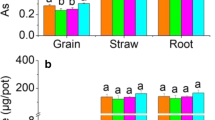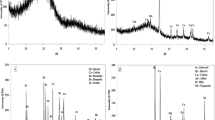Abstract
Mining and geogenic activities can lead to elevated concentrations of potentially toxic elements in soil. Biochar amendment to soil is a cost-effective technology and environmentally friendly approach to control soil pollution, improve phytoremediation and mitigate health risks due to agricultural products. Greenhouse pot experiments were conducted to investigate the effects of rice husk biochar on alfalfa biomass, metal bioaccumulation and arsenic speciation. Results indicated that rice husk biochar amendments to contaminated soil increased plants biomass by improving soil fertility and available nutrients. Biochar also increased soil cation change capacity, dissolved organic carbon, while decreased available concentrations of potentially toxic elements (except for arsenic). The accumulation of nickel, lead, cadmium and zinc (except for chromium and arsenic) significantly (P ≤ 0.05) decreased as compared with unamended control plants. In addition, increases were observed for inorganic arsenite and arsenate. Current findings demonstrate that rice husk biochar can be used as a beneficial amendment for contaminated soil. However, further field experiments are needed to validate its long-term effectiveness where environmental factors are diverse and complex.


Similar content being viewed by others
Change history
03 October 2017
The original version of this article unfortunately contained a mistake. One affiliation and one author were missing. The corrected affiliations and authors are given here.
References
Abedin MJ, Feldmann J, Meharg AA (2002) Uptake kinetics of arsenic species in rice plants. Plant Physiol 128:1120–1128
Ahmad M, Lee SS, Yang JE, Ro HM, Lee YH, Ok YS (2012) Effects of soil dilution and amendments (mussel shell, cow bone, and biochar) on Pb availability and phytotoxicity in military shooting range soil. Ecotoxicol Environ Saf 79:225–231
Chen Z, Chen C, Liu Y, Wu Y, Yang S, Lu C (1992) Study on soil background values in Fujian province. Chin J Environ Sci 13:70–75
Cheng CH, Lehmann J, Thies JE, Burton SD, Engelhard MH (2006) Oxidation of black carbon by biotic and abiotic processes. Org Geochem 37:1477–1488
Feng W, Hatt BE, McCarthy DT, Fletcher TD, Deletic A (2012) Biofilters for storm water harvesting: understanding the treatment performance of key metals that pose a risk for water use. Environ Sci Technol 46:5100–5108
Ghosh S, Ow LF, Wilson B (2015) Influence of biochar and compost on soil properties and tree growth in a tropical urban environment. Int J Environ Sci Technol 12:1303–1310
Houben D, Evrard L, Sonnet P (2013) Mobility, bioavailability and pH-dependent leaching of cadmium, zinc and lead in a contaminated soil amended with biochar. Chemosphere 92:1450–1457
Jarup L, Berglund M, Elinder CG, Nordberg G, Vahter M (1998) Health effects of cadmium exposure—a review of the literature and a risk estimate. Scand J Work Environ Health 24:1–51
Jia Y, Huang H, Sun GX, Zhao FJ, Zhu YG (2012) Pathways and relative contributions to arsenic volatilization from rice plants and paddy soil. Environ Sci Technol 46:8090–8096
Khan S, Waqas M, Ding F, Shamshad I, Arp HPH, Li G (2015) The influence of various biochar on the bioaccessibility and bioaccumulation of PAHs and potentially toxic elements to turnips (Brassica rapa L.). J Hazard Mater 300:243–253
Kołodyńska D, Wnętrzak R, Leahy J, Hayes M, Kwapiński W, Hubicki Z (2012) Kinetic and adsorptive characterization of biochar in metal ions removal. Chem Eng J 197:295–305
Komkiene J, Baltrenaite E (2016) Biochar as adsorbent for removal of heavy metal ions [Cadmium(II), Copper(II), Lead(II), Zinc(II)] from aqueous phase. Int J Environ Sci Technol 13:471–482
Liang B, Lehmann J, Solomon D, Kinyangi J, Grossman J, O’neill B, Skjemstad J, Thies J, Luizao F, Petersen J (2006) Black carbon increases cation exchange capacity in soils. Soil Sci Soc Am J70:1719–1730
Lu K, Yang X, Shen J, Robinson B, Huang H, Liu D, Bolan NS, Pei J, Wang H (2014) Effect of bamboo and rice straw biochars on the bioavailability of Cd, Cu, Pb and Zn to Sedum plum bizincicola. Agr Ecosyst Environ 191:124–132
Luxton TP, Eick MJ, Rimstidt DJ (2008) The role of silicate in the adsorption/desorption of arsenite on goethite. Chem Geol 252:125–135
Major J, Rondon M, Molina D, Riha SJ, Lehmann J (2012) Nutrient leaching in a Colombian savanna oxisol amended with biochar. J Environ Qual 41:1076
Martinsen V, Mulder J, Shitumbanuma V, Sparrevik M, Børresen T, Cornelissen G (2014) Farmer-led maize biochar trials: effect on crop yield and soil nutrients under conservation farming. J Plant Nutri Soil Sci 177(5):681–695
McLaughlin MJ, Parker D, Clarke J (1999) Metals and micronutrients, food safety issues. Field Crops Res 60:143–163
Meharg A, Macnair M (1992) Suppression of the high affinity phosphate uptake system: a mechanism of arsenate tolerance in Holcuslanatus L. J Exp Bot 43:519–524
Méndez A, Terradillos M, Gascó G (2013) Physicochemical and agronomic properties of biochar from sewage sludge paralyzed at different temperatures. J Anal Appl Pyrol 10:124–130
Namgay T, Singh B, Singh BP (2010) Influence of biochar application to soil on the availability of As, Cd, Cu, Pb, and Zn to maize (Zea mays L.). Aust J Soil Res 48:638–647
Park JH, Choppala GK, Bolan NS, Chung JW, Chuasavathi T (2011) Biochar reduces the bioavailability and phytotoxicity of heavy metals. Plant Soil 348:439–451
Pratas J, Favas PJ, Souza DR, Varun M, Paul MS (2013) Phytoremedial assessment of flora tolerant to heavy metals in the contaminated soils of an abandoned Pb mine in Central Portugal. Chemosphere 90:2216–2225
Petrikova V, Ustjak S, Roth J (1995) Heavy-metals contamination of agricultural crops and soils in five regions of the Czech-republic with different emission pollution load. Rostlinna Vyroba 41:17–23
Rayment G, Higginson FR (1992) Australian laboratory hand book of soil and water chemical methods. Inkata Press Pty Ltd
Sharma P, Kappler A (2011) Desorption of arsenic from clay and humic acid coated clay by dissolved phosphate and silicate. J Contam Hydrol 126:216–222
Smoke T, Smoking I (2004) IARC monographs on the evaluation of carcinogenic risks to humans. IARC, Lyon1-1452
Steinbeiss S, Gleixner G, Antonietti M (2009) Effect of biochar amendment on soil carbon balance and soil microbial activity. Soil Biol Biochem 41:1301–1310
Wong CSC, Li XD (2004) Pb contamination and isotopic composition of urban soils in Hong Kong. Sci Total Environ 319:185–195
Xu X, Cao X, Zhao L (2013) Comparison of rice husk-and dairy manure-derived biochar for simultaneously removing heavy metals from aqueous solutions: role of mineral components in biochar. Chemosphere 92:955–961
Yu XY, Ying GG, Kookana RS (2009) Reduced plant uptake of pesticides with biochar additions to soil. Chemosphere 76:665–671
Zheng RL, Cai C, Liang JH, Huang Q, Chen Z, Huang YZ, Arp HPH, Sun GX (2012) The effects of biochar from rice residue on the formation of iron plaque and the accumulation of Cd, Zn, Pb, As in rice (Oryza sativa L.) seedlings. Chemosphere 89:856–862
Zheng R, Chen Z, Cai C, Wang X, Huang Y, Xiao B, Sun G (2013) Effect of biochar from rice husk, bran, and straw on heavy metal uptake by pot-grown wheat seedling in a historically contaminated soil. Bio Resour 8:5965–5988
Acknowledgments
This study was financially supported by National Scientific Foundation of China (Grant No. 41501519), National High-Tech R&D Program of China and the International Science, Technology Cooperation Program and the Chinese Academy of Sciences under the CAS President’s International Fellowship Initiative (PIFI, Grant No. 2015VEB055).
Author information
Authors and Affiliations
Corresponding author
Additional information
Editorial responsibility: J. Aravind
A correction to this article is available online at https://doi.org/10.1007/s13762-017-1587-5.
Electronic supplementary material
Below is the link to the electronic supplementary material.
Rights and permissions
About this article
Cite this article
Ibrahim, M., Khan, S., Hao, X. et al. Biochar effects on metal bioaccumulation and arsenic speciation in alfalfa (Medicago sativa L.) grown in contaminated soil. Int. J. Environ. Sci. Technol. 13, 2467–2474 (2016). https://doi.org/10.1007/s13762-016-1081-5
Received:
Revised:
Accepted:
Published:
Issue Date:
DOI: https://doi.org/10.1007/s13762-016-1081-5




